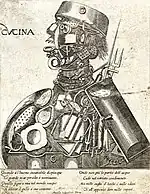Cyborg art
Cyborg art, also known as cyborgism,[1] is an art movement that began in the mid-2000s in Britain.[2] It is based on the creation and addition of new senses to the body via cybernetic implants[3] and the creation of art works through new senses.[4] Cyborg artworks are created by cyborg artists;[5] artists whose senses have been voluntarily enhanced through cybernetic implants.[6] Among the early artists shaping the cyborg art movement are Neil Harbisson, whose antenna implant allows him to perceive ultraviolet and infrared colours,[7] and Moon Ribas whose implants in her feet[8] allow her to feel earthquakes and moonquakes.[9] Other cyborg artists include:
- Manel De Aguas, a Catalan photographer who developed fins that allow him to perceive atmospheric pressure, humidity and temperature through a couple of implants at each side of his head.[10]
- Joe Dekni, an artist who has developed and installed a radar system in his head. The sensory system includes two implants in his cheekbones.[11]
- Pau Prats, creator of a system that allows him to feel the ultraviolet ray levels that reach his skin.[12][13]
- Alex Garcia, whose sensor installed in his chest allows him to feel the air quality levels around him.[14]
- Kai Landre, a musician developing two implants to hear the sound of the particles affected by the collusion of cosmic rays.[15]
- Hannah Meltzer, a visual and performance artist who has magnets implanted in her fingers and ears which allow her to feel magnetic fields.[16][17]
- Dodo K. Doudová, Czech autism rights advocate who has a sensor that allows them to feel ionizing radiation on their own skin as vibrations and a subdermal chip implant. [18][19][20]
| Part of a series on |
| Cyborgs |
|---|
 |
| Cyborgology |
| Theory |
| Centers |
| Politics |
| Related articles |
See also
References
- Barbato, Massimo (2016-01-19). "The Art of Cybernetic Union - SERIOUS WONDER". Serious Wonder. Retrieved 2016-01-19.
- Jeffries, Stuart "Neil Harbisson, the world's first cyborg artist", The Guardian, 5 May 2014
- "I Don't Have Artificial Body Parts, I Have Artistic Body Parts". The Huffington Post. 2015-03-12. Retrieved 2016-01-19.
- Else, Liz "Cyborg makes art using seventh sense", The New Scientist, 29 June 2012
- Alexander, Neta (2015-05-26). "They Dance the Body Electric: Cyborg Artists Land in Central Israel". Haaretz. Retrieved 2016-01-19.
- Lee, Jennifer "A Surgical Implant for Seeing Colors Through Sound", The New York Times, 2 July 2012
- NBC, "Last Call with Carson Daly" Archived 2016-04-12 at the Wayback Machine, 29 September 2014
- Garcia, Gabriella "The woman who can feel every earthquake in the world", "Hopes&Fears", 17 de octubre 2015.
- Davis, Sally. “Encounters with the Posthuman”, Nautilus, 29 April 2013.
- Gabilondo, Pablo "El catalán que va a implantarse un barómetro para predecir el tiempo: "Quiero ser cíborg", El Confidencial, 13 August 2017
- "A new Cyborg is Born, by Joe Dekni | momo-mag". www.momo-mag.com (in European Spanish). 16 October 2018. Retrieved 2018-10-17.
- 20Minutos (2019-02-12). "Vídeo: El chico ultravioleta". 20minutos.es - Últimas Noticias (in Spanish). Retrieved 2019-07-06.
- "Meet Pau Prats, the cyborg with a radiation sensing organ". Biohackinfo. Retrieved 2019-08-10.
- "La vida de los ciborgs: El adolescente que siente la contaminación". www.msn.com. Retrieved 2019-07-06.
- Graafstra, Viktoria Modesta, Neil Harbisson, Amal (2018-09-06). "Designing our bodies for the future". CNN Style. Retrieved 2019-07-06.
{{cite web}}: CS1 maint: multiple names: authors list (link) - Filho, Claudio. “Poéticas Do Tecnológico: Identidade Humana Em Colapso.” V Seminário de Artes Digitais: projeções e memória na arte (2019): n. pag. Print.
- "Re My Life as a Cyborg". YouTube.
- DODO: Jsem kyborg a umím vnímat radioaktivitu, ráda bych se potkala s paní Drábovou, retrieved 2022-12-29
- Fedorovičová, Andrea (2022-08-30). "Dali by ste si implantovať čip?". VEDA NA DOSAH (in Slovak). Retrieved 2022-12-29.
- Fedorovičová, Andrea (2022-08-30). "Dodo: Kyborgovia sa nepovažujú za niečo viac než iní ľudia či zvieratá". VEDA NA DOSAH (in Slovak). Retrieved 2022-12-29.
This article is issued from Wikipedia. The text is licensed under Creative Commons - Attribution - Sharealike. Additional terms may apply for the media files.